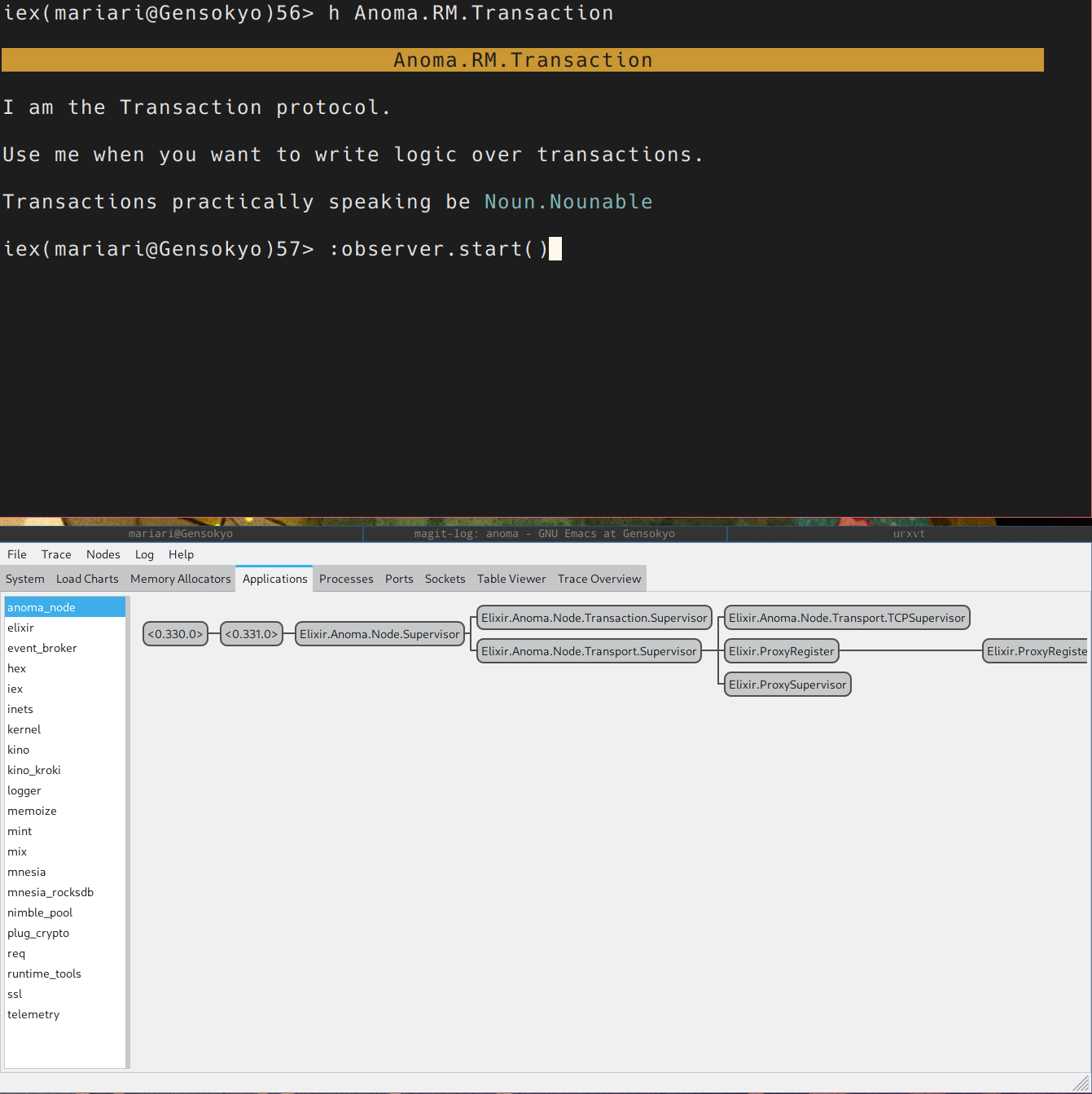Anoma in Elixir
This article explains why Anoma is built using the Elixir programming language.

Summary
This article explains why Anoma is built using the Elixir programming language:
- Elixir lets developers inspect the system while it's running, and update its running code without restarting.
- Elixir compiles to Erlang, a well-established programming system designed for building robust, fault-tolerant networked systems with a "let it crash" philosophy.
- There's a natural fit between Elixir's "agent model", and Anoma's architecture, which is based on message-passing "engines".
- As the structure of the language matches the design of the system, implementation complexity decreases.
- The above properties ease formal verification efforts.
Hence Elixir provides the right abstractions to build Anoma according to its specification, and delivers a good developer experience while promising support for future verification.
Anoma: Why Elixir?
Anoma is a decentralized operating system with heterogeneous trust. It has the following properties:
- It has to support a large network of interacting actors.
- It has to be robust.
- Its core components are "engines"
Elixir, therefore, seems suitable for our implementation.
- Its interactive environment supports both productive development practices and multi-agent system analysis.
- The OTP basis fosters application robustness.
- There is a correlation between engines and GenServers.
Let us explicate these points:
Live Interactive Systems
When building any system, there are two core features a developer needs:
- Understand how the system is operating.
- Determine if there are mishaps when carrying out a design.
For most software projects, this means, accordingly:
- Thinking about the code in abstract (...which can be time-consuming).
- Tracing through the system execution (...which can be obscure).
Thankfully, Elixir rests on the foundations of Erlang/OTP. In practical terms, this means that we get a live interactive environment to ask questions about our system. The specific features it lends us are:
- Hot code reloading
- This means that we can have the software running locally, and be able to change any part of it without having to shut down and restart the service. This is invaluable for trying to experiment with new ideas!
- Underlying environmental reflection
- The underlying reflection gives the system the information it needs to be able to report back. Without inroads to the system, an interactive system would quickly turn opaque!
- The entire system available (from parser to compiler, to
visualization suite) from the user shell
- This allows a skilled engineer the ability to diagnose problems and see practical implications of what they are doing. This is a part of the same technology that allowed people to debug a space probe 100 million miles away!
- A lack of artificial distinction between system and language.
- This means that the core functionality of the system is realized through the language itself, proving itself capable enough to compose a highly robust system.
Instead of having to simply sit and think about the architecture of how the components of the implementation fit together, these tools allow us to ask the underlying system, "Please give us the layout of Anoma processes":

The specifics of the diagram don't matter. What does is that the system can reflect on itself, helping to explain the very system that we are building. Meaning, that the implementation can be in dialog with the builders to shape discussion around itself. For example what if we were curious about one of those nodes in the diagram, what information can we get from there?:

As we can see, we now have diagnostics on the particular node along with information about its state, stack trace, etc.
With these properties and features laid out, this makes Elixir quite different from commonly used languages (Java, Rust, Python, etc.)
With that said, there are genres of languages that exhibit the same features some of which have superior visualization techniques. What is it about the Erlang/OTP system that makes them special compared to them?
Designing Robust Systems
To understand what makes Elixir special, we first must go back to what problems Erlang and the Beam were meant to solve. Joe Armstrong's thesis: Making reliable distributed systems in the presence of software errors, lays out their problem domain:
- The system must handle large numbers of concurrent activities
- Actions must be performed at a certain point in time or within a certain time.
- Systems may be distributed over several computers.
- The system is used to control hardware.
- The software systems are very large.
- The system exhibits complex functionality such as feature interaction.
- The system should be in continuous operation for many years.
- Software maintenance should be performed without stopping the system.
- There are stringent quality and reliability requirements
- Fault tolerance both to hardware failures, and software errors, must be provided.
To tackle these problems he created a philosophy and requirements that the underlying operating system and language should have, creating Erlang/OTP.
To give a sample of the features the system has:
-
The system has very cheap processes
elixir iex(mariari@Gensokyo)10> :timer.tc(fn -> spawn(fn -> nil end) end) {10, #PID<0.1689.0>}- This snippet shows a process takes only 10 microseconds to spawn!
-
The architecture of the application is split into a series of processes, each process is often referred to as actors.
- Actors are interesting objects as here are their central properties:
- They contain some state they maintain
- They can send and receive messages
- Messages are processed sequentially (order is guaranteed) between the same two actors!
- Actors are interesting objects as here are their central properties:
-
Processes are isolated. Meaning that if a process crashes, it does not affect other processes. Erlang the movie gives a good example of this at play on their real systems!
-
Processes are managed by a chain of supervisors.
- Supervisors are interesting in that they look after many processes. When a process they are supervising crashes, they have policies on what happens to the other processes under their control.
- It was realized that actors on their own are not enough to make a robust system, and this is a crucial component that is missing from most other actor models.
-
The mentality is "let it crash".
- With Supervisors, this is a very potent strategy for creating
reliable and robust systems.
- When crashes happen early, we can isolate the errors, this is hard to do when one has an Either/Result/Maybe type, as stack information is often lost with those strategies. The supervisor then can restart the crashed component helping the system resume normal behavior.
- Further, since parts of the system being down can be normal, one typically thinks out a robust supervision system that lets the system gracefully degrade. A common example is having a full fledged system that does all the bells and whistles, however when some external service is down (say you query an external service for images or AI responses), then we can fall back on simpler behavior until the issue is solved.
- This also helps in the case of underlying hardware errors, as if something like a bit flip due to a cosmic ray were to happen to a high-integrity component, instead of the application crashing and stopping, the application could crash and sensible restart behavior can be had.
- With Supervisors, this is a very potent strategy for creating
reliable and robust systems.
-
The system has fair concurrency, with its own scheduler system.
- This means your processes aren't going to get starved of resources.
These are just a few of the features that make the Erlang/OTP system stand out even among other interactive systems. Robustness is essential for a large-scale system of interacting agents.
However, are there any Anoma-specific requirements that Elixir helps fulfill? To answer this, we have to consult the specification.
Implementing an Engine
Anoma is an idea, made concrete in a protocol specification. It is the source of truth that the implementation should follow. Its primary value is being a model of an attractive idea, which will drive the users to interact with the codebase.
Therefore it is of utmost importance that the implementation corresponds as clearly and as naturally as possible to the specification. This is, what the user is looking for is an instantiation of the presented proposal with desired properties. That is, they need to be certain that a piece of code lying inside a repository is an actual implementation of the system described.
To make this process easy, the engineers need to have a good interface that makes establishing a connection between concepts central to the specification and our code as trivial as possible.
For example, if you are interested in functions, it matters whether you present id : Bool -> Bool as lambda x -> x or {{true, true}, {false, false}}. There is a reason why we don't use set theory everywhere in mathematics. If you think of functions as something that takes things in and pops things out, the type-theoretic approach is probably easier to comprehend and work with.
Following this idea, a good requirement for the desired language is to have a good first-class citizen corresponding to the central concept of the specification: the engine. Almost every functionality in the Anoma infrastructure is specified as a functionality of a particular engine. E.g. Mempool behavior is implemented through the Mempool Engine; Transaction execution is implemented through the Execution Engine.
An engine has several properties, which notably include:
- It is stateful
- It can receive messages
- It can send messages
- Messages are processed sequentially
So what is an engine? Something that looks like an agent, it seems! Now what systems take agents as first-class citizens? From the previous section, we now know that Erlang-based systems do that!
Having a good actor model of the language we use does not only allow for an easier understanding of the codebase, greater engagement with parties interested in Anoma development coming from the specification side, it also grants us credence in future verification and auditing work being done internally.
The formal verification efforts Anoma has are aimed not at the verification of a particular implementation: implementations may differ and canonical ones may change due to timely choices. Instead, proving of system properties will be done through the formalization of the Anoma specification. As it goes, a proof is only as good as the initial formalization of the system. The closer the underlying concepts of the specification and the implementation are, the more believable it is that whatever we come to prove about Anoma will also correspond to a proof about our Elixir implementation.
Conclusion
We have chosen Elixir to develop the Anoma node software. The Anoma node consists of several independently moving pieces that have to be orchestrated and connected (e.g., transaction execution, intra-node communication, configuration, etc.). From a developer's perspective it is beneficial to be able to introspect these individual components at runtime, update them, and manipulate them. Additionally, the Erlang VM offers us the basic building blocks to build and connect such a system of independent processes in a robust and scalable way.
The specification of Anoma dictates that any node consists of different 'engines', which are isolated processes each responsible for handling part of the Anoma node responsibilities. The Erlang VM its computational model of processes with shared-nothing memory maps nearly 1:1 on the architecture proposed in the Anoma specification. This means that the implementation of the specification will have much less accidental complexity compared to other computational models.
Thus, choosing the Erlang VM to implement the Anoma specification offers us better developer UX and reduces the impedance mismatch between the specification of Anoma and its physical implementation.